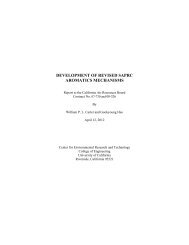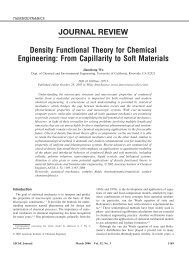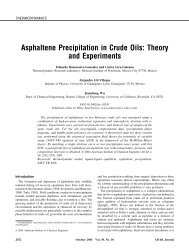Gas-Phase Ozone Oxidation of Monoterpenes: Gaseous and ...
Gas-Phase Ozone Oxidation of Monoterpenes: Gaseous and ...
Gas-Phase Ozone Oxidation of Monoterpenes: Gaseous and ...
You also want an ePaper? Increase the reach of your titles
YUMPU automatically turns print PDFs into web optimized ePapers that Google loves.
GAS-PHASE OZONE OXIDATION OF MONOTERPENES 209<br />
ives exhibit several pseudo-molecular ions, allowing unambiguous determination<br />
<strong>of</strong> molecular weights. The EI mass spectra allow functional group identification<br />
by exhibiting ions characteristic <strong>of</strong> each functional group: m/z 181 for carbonyl,<br />
<strong>and</strong> m/z 73 <strong>and</strong> 75 for carboxyl <strong>and</strong> hydroxy groups. In addition, each functional<br />
group is associated with a unique set <strong>of</strong> pseudo-molecular ions in CI spectra. The<br />
PFBHA-carbonyl derivatives give rise to pseudo-molecular ions at m/z M+181,<br />
M-181 <strong>and</strong> M-197, whereas the TMS derivatives <strong>of</strong> OH/COOH containing compounds<br />
have pseudo-molecular ions at m/z M+73, M-15 <strong>and</strong> M-89. We refer the<br />
reader to Yu et al. (1998) for a detailed description <strong>of</strong> the mass spectra fragment<br />
patterns.<br />
2. Experimental Section<br />
2.1. SMOG CHAMBER EXPERIMENTS AND SAMPLE COLLECTION<br />
Samples were collected from a series <strong>of</strong> β-pinene/O 3 , sabinene/O 3 , α-pinene/O 3 ,<br />
<strong>and</strong> 3 -carene/O 3 experiments, conducted in the dark in a 60-m 3 Teflon reactor,<br />
which has been described previously (H<strong>of</strong>fmann et al., 1997; Griffin et al., 1999).<br />
When fully inflated, the reactor has a surface to volume ratio (S/V) <strong>of</strong> 1.8 m −1 .<br />
This reactor was normally divided in the center so that two experiments could<br />
be run under identical environmental conditions. The temperature in the reactor<br />
was maintained between 305 <strong>and</strong> 310 K to approximate that <strong>of</strong> a typical afternoon<br />
smog chamber experiment. To achieve this, the entire reactor was covered with<br />
an insulating cover as well as a black tarpaulin. In addition, four Holmes (Milford,<br />
MA) Model HFH-501FP space heaters were placed in the open area underneath the<br />
reactor. In a typical experiment, seed particles <strong>of</strong> (NH 4 ) 2 SO 4 were injected into the<br />
chamber to obtain initial particle concentrations <strong>of</strong> approximately 9,000–17,000<br />
particle cm −3 . The initial size distribution <strong>of</strong> the seed aerosol was centered around<br />
100 nm. The aerosol size distribution <strong>and</strong> total number concentrations <strong>of</strong> each side<br />
<strong>of</strong> the reactor were monitored at a one-minute frequency using a TSI (St. Paul,<br />
MN) Model 3071 cylindrical scanning electrical mobility spectrometer (SEMS)<br />
<strong>and</strong> a TSI Model 3760 condensation nucleus counter (CNC). Particle losses in the<br />
SEMS, SEMS response functions, particle charging efficiencies, CNC charging<br />
efficiencies, <strong>and</strong> particle deposition in the reactor have been taken into account<br />
in the analysis <strong>of</strong> the aerosol data (Wang et al., 1992). The initial monoterpene<br />
mixing ratio ranged from 50 to 110 ppbv, <strong>and</strong> an appropriate amount <strong>of</strong> 2-butanol<br />
was also added to the reactor to scavenge >95% <strong>of</strong> OH radicals produced from the<br />
monoterpene-O 3 reaction (Chew <strong>and</strong> Atkinson, 1996; Atkinson, 1997). Finally,<br />
ozone was injected to the reactor using an Enmet Corporation (Ann Arbor, MI,<br />
U.S.A.) Model 04052-011 O 3 generator until the O 3 mixing ratio reaches at approximately<br />
four times that <strong>of</strong> the initial hydrocarbon for all experiments except<br />
one α-pinene/O 3 <strong>and</strong> one β-pinene/O 3 experiment, in which excessive hydrocarbon<br />
was established in the reactor. Table I summarizes the initial conditions <strong>of</strong> each<br />
experiment.
















